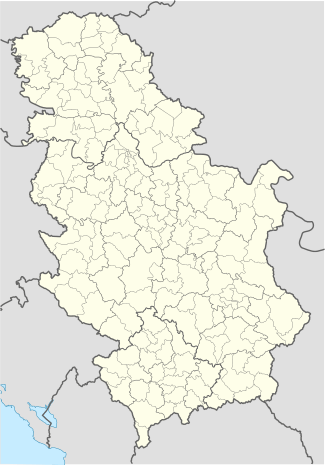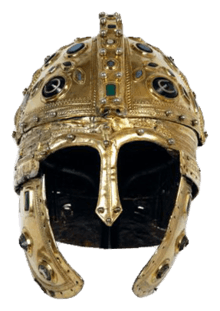Sirmium
|
Ruins of Imperial Palace at Sirmium | |
 Shown within Serbia | |
| Location | Sremska Mitrovica, Serbia |
|---|---|
| Region | Pannonia |
| Coordinates | 44°59′N 19°37′E / 44.983°N 19.617°ECoordinates: 44°59′N 19°37′E / 44.983°N 19.617°E |
| Type | Settlement |
| History | |
| Founded | Before 4th century BC |
| Abandoned | 582 |
| Cultures | Illyrian, Celt, Roman, Byzantine |
| Site notes | |
| Condition | In ruins |
| Public access | Yes |
Sirmium was a city in Pannonia, an ancient province of the Roman Empire. First mentioned in the 4th century BC and originally inhabited by the Illyrians and Celts,[1] it was conquered by the Romans in the 1st century BC and subsequently became the capital of the Roman province of Pannonia Inferior. In 294 AD, Sirmium was pronounced one of the four capitals of the Roman Empire. It was also the capital of the Praetorian prefecture of Illyricum and of Pannonia Secunda Province. Sirmium was located on the Sava river, on the site of modern Sremska Mitrovica in Vojvodina province, northern Serbia. The Republic of Serbia declared its site an Archaeological Sites of Exceptional Importance in 1990. The modern region of Syrmia (Srem) is named after it.
Sirmium had 100,000[2] inhabitants and was one of the biggest cities of its time. Colin McEvedy, however, put the population at only 7,000, based on the size of the archaeological site.[3] Ammianus Marcellinus called it "the glorious mother of cities".
History


Remains of Sirmium stand on the site of the modern-day Sremska Mitrovica, 55 km west of Belgrade (Roman Singidunum) and 145 km away from Kostolac (Roman Viminacium). Archaeologists have found traces of organized human life on the site of Sirmium dating from 5,000 BC.[4] The city was firstly mentioned in the 4th century BC and was originally inhabited by the Illyrians and Celts[5] (i.e. by the Pannonian-Illyrian Amantini[6] and the Celtic Scordisci[7]). The Triballian King Syrmus was later considered the eponymous founder of Sirmium, but the roots are different, and the two words only became conflated later.[8] The name Sirmium by itself means "flow", "flowing water", "wetland", referring to its close river position on the nearby Sava, Latin Savus.
With the Scordisci as allies, the Roman proconsul Marcus Vinicius took Sirmium in around 14 BC.[9][10] In the 1st century AD, Sirmium gained a status of a colony of the citizens of Rome, and became an important military and strategic center of Pannonia province. The Roman emperors Trajan, Marcus Aurelius, and Claudius II prepared war expeditions in Sirmium.
In 103 Pannonia was split into two provinces: Pannonia Superior and Pannonia Inferior, and Sirmium became the capital city of the latter.
In 296 Diocletian reorganized Pannonia into four provinces: Pannonia Prima, Pannonia Valeria, Pannonia Savia and Pannonia Secunda, and Sirmium became the capital of Pannonia Secunda. He joined them with Noricum and Dalmatia to establish the Diocese of Pannonia, with Sirmium as its capital also.
In 293, with the establishment of tetrarchy, the Roman Empire was split into four parts; Sirmium emerged as one of the four capital cities (along with Trier, Mediolanum, and Nicomedia) of the Roman Empire, and was the capital of emperor Galerius. With the establishment of Praetorian prefectures in 318, the capital of the prefecture of Illyricum was Sirmium, remaining so until 379, when the westernmost Diocese of the Praetorian prefecture of Illyricum, Pannonia (including Sirmium), was detached and joined to the Praetorian prefecture of Italia assuming the name of Diocese of Illyricum. The eastern part of Illyricum remained a separate prefecture under the East Roman Empire with its new capital in Thessalonica.
From the 4th century, the city was an important Christian center, and the seat of the Bishop of Sirmium. Five church councils, the Councils of Sirmium, took place in Sirmium. The city also had an imperial palace, a horse-racing arena, a mint, an arena theatre, and a theatre, as well as many workshops, public baths, temples, public palaces and luxury villas. Ancient historian Ammianus Marcellinus called it "the glorious mother of cities".
The mint in Sirmium was connected with the mint in Salona and silver mines in the Dinaric Alps through the Via Argentaria.
At the end of the 4th century Sirmium came under the sway of the Goths, and later, was again annexed to the Eastern Roman Empire. In 441 the Huns conquered Sirmium; it remained for more than a century in the hands of various other tribes, such as Eastern Goths and Gepids. For a short time, Sirmium was the centre of the Gepid State and King Cunimund minted gold coins there. After 567, Sirmium reverted to the Eastern Roman Empire. The Avars conquered and destroyed the city in 582.
Roman emperors
Ten Roman emperors were born in this city or in its surroundings:
- Herennius Etruscus (251)
- Hostilian (251)
- Traianus Decius (249–51)
- Claudius II (268-270)
- Quintillus (270)
- Aurelian (270–75)
- Probus (276–82)
- Maximianus Herculius (285–310)
- Constantius II (337–61)
- Gratian (367–83)
The last emperor of the united Roman Empire, Theodosius I (378–95), became emperor in Sirmium. The usurpers Ingenuus and Regalianus also declared themselves emperors in this city (in 260) and many other Roman emperors spent some time in Sirmium including Marcus Aurelius who might have written parts of his famous work Meditations in the city. Sirmium was, most plausibly, the site of the death of Marcus Aurelius, of smallpox, in March of 180 CE. McLynn, Frank, Marcus Aurelius, Da Capo Press (2009), p. 417.
Archeological findings
- On the location Glac near Sirmium is found unexcavated the palace of Emperor Maximianus Herculius built on the place where his parents worked as laborers on the estate of a Roman column. During the construction of the hospital in 1971, was found in monumental Jupiter's sanctuary with more than eighty of the altar, which is the second largest in Europe. Sirmium had two bridges with which she was bridged river Sava, of which indicate the historical sources, bridge Ad Basanti and Artemida's bridge. After the 313th the Sirmium became an important Christian center. So far, it was revealed eight early Christian churches, of which they are dedicated to St. Irenaeus, St. Demetrius. and Sv. Sinenot.
- During work on the new Sremska Mitrovica trade center in 1972, a worker accidentally broke into an old Roman pot, about 2m deep, over the site of an old Sirmium settlement. 33 gold Roman coins enclosed in a leather pouch were found inside a Roman house wall, probably the hidden savings of a wealthy Roman family stashed centuries ago. Of this extraordinary rare find of Sirmium minted coins were 4 Constantius II era coins, considered the most valuable examples from the late Roman Empire of the fourth century AD. Ironically, the worker's name was Zlatenko (meaning Golden, or Golden Man in Serbian, Aurelius in Latin).
- The only known unexcavated Roman Hippodrome in the world is in Sirmium.[11][12][13] A colossal building about 150m wide and 450m long lies directly under the Sremska Mitrovica town center and just beside the old Sirmium Emperor's Palace (one of just a few Sirmium publicly accessible archeological sites). The presence of the arena has clearly affected the layout of the present town (Sremska Mitrovica is today about 2–4m above ground line of former Sirmium settlement). Recently announced cultural and archeological projects for preserving and popularising Sirmium sites haven't included any activity dealing with the arena, probably due to the extent of the large arena — the entire present town center might have to be excavated.
Famous residents
.jpg)
- Marcus Aurelius, Roman emperor (161–180), used Sirmium as a residence in between Pannonian military campaigns 170–180
- Maximinus, Roman emperor (235–238), ruled from residence in Sirmium.
- Herennius Etruscus, Roman emperor (251), born in Sirmium.
- Hostilian, Roman emperor (251), born in Sirmium
- Decius Traian, Roman emperor (249–251), born in village Budalia near Sirmium.
- Ingenuus, Roman emperor (260), proclaimed himself emperor in Sirmium.
- Regalianus, Roman emperor (260), proclaimed himself emperor in Sirmium.
- Claudius II, Roman emperor (268–270), born in Sirmium and spent most of his life there.
- Quintillus, Roman emperor (270), born in Sirmium
- Aurelian, Roman emperor (270–275), born in Sirmium and also proclaimed emperor there.
- Probus, Roman emperor (276–282), born in Sirmium.
- Maximianus Herculius, Roman emperor (285–310), born near Sirmium.
- Galerius, Roman emperor (305–311), ruled as Caesar during the Tetrarchy from residence in Sirmium (293–296).
- Crispus, a Caesar of the Roman Empire. He was proclaimed Caesar in Sirmium in 317.
- Constantine II, a Caesar of the Roman Empire. He was proclaimed Caesar in Sirmium in 317.
- Vetranion, Roman emperor. Proclaimed himself emperor in Sirmium (in 350).
- Constantius II, Roman emperor (337–361), born in Sirmium.
- Gratian, Roman emperor (367–383), born in Sirmium.
- Theodosius I the Great, Roman emperor (378–395). He became emperor in Sirmium.
- Valerius Licinius, prefect of the Diocese of Pannonia with residence in Sirmium (308–314).
- Apricanus, prefect of the Pannonia Secunda province with residence in Sirmium (355).
- Mesala, prefect of the Pannonia Secunda province (373).
- Petronius Probus, prefect in Sirmium (374).
- Aurelius Victor, prefect of the Pannonia Secunda province (369), and author of a History of Rome until the reign of Julian.
- Leontius, prefect in Sirmium (426).
See also
- Archaeological Sites of Exceptional Importance
- Circus
- Council of Sirmium
- Praetorian prefecture
- Praetorian prefecture of Illyricum
- Roman Empire
- Roman provinces
- Sremska Mitrovica
- Syrmia
- Tetrarchy
References
- ↑ "Mesto Sremska Mitrovica, upoznaj Srbiju". Retrieved 1 October 2014.
- ↑ "SREMSKA MITROVICA IN ROMAN TIMES". Retrieved 1 October 2014.
- ↑ McEvedy, Cities of the Classical World, (London: Allen Lane, 2011), p.346.
- ↑ "SREMSKA MITROVICA IN ROMAN TIMES". Retrieved 1 October 2014.
- ↑ "Mesto Sremska Mitrovica, upoznaj Srbiju". Retrieved 1 October 2014.
- ↑ "SRCE.hr". Retrieved 1 October 2014.
- ↑ "VML.de". Retrieved 1 October 2014.
- ↑ Fanula Papazoglu, The central Balkan tribes in pre-Roman times, Hakkert, 1978. ISBN 90-256-0793-4. p.74.
- ↑ Ronald Syme, Anthony Birley, The provincial at Rome: and, Rome and the Balkans 80BC-AD14, p. 204 Google Books
- ↑ Alan K. Bowman, Edward Champlin, Andrew Lintott, The Cambridge ancient history 10:551 Google Books
- ↑ Sirmium. Retrieved 1 October 2014.
- ↑ Roman Circuses. Retrieved 1 October 2014.
- ↑ Bradt Travel Guide Serbia. Retrieved 1 October 2014.
Further reading
- Petar Milošević, Arheologija i istorija Sirmijuma, Novi Sad, 2001.
- Radomir Popović, Rano hrišćanstvo u Panoniji, Vojvođanski godišnjak, sveska I, Novi Sad, 1995.
External links
| Wikimedia Commons has media related to Sirmium. |
